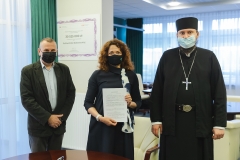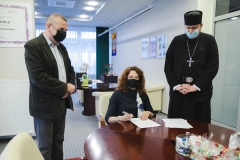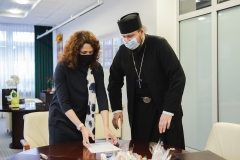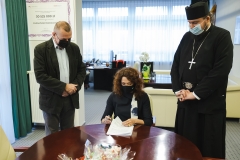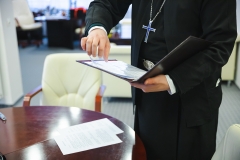Bialystok University of Technology together with three universities will support the protection of unique Supraśl catacombs
20-12-2021
– Our joint project carried out by the Monastery of the Annunciation of the Blessed Virgin Mary in Supraśl and now by the rectors of Białystok universities concerns the catacombs, that is, the great historical and cultural heritage, not only of the Supraśl Monastery, not only of the Orthodox Church in Poland, but also of the whole region and our whole country – explains ihumen Pantelemon Karczewski from the Monastery of the Annunciation of the Blessed Virgin Mary. The catacombs were built in the mid-16th century.
– It is a challenge for Bialystok University of Technology, but also a participation in a very prestigious undertaking – says Assoc. Prof. Marta Kosior-Kazberuk, DSc, PhD, Eng, Rector of Bialystok University of Technology. – I am convinced that experts in the field of historic monument conservation, building materials, material engineering, as well as land development will be useful in the implementation of this project.
Archaeologists have been aware for years of the uniqueness of the catacombs and their exceptional historical value. Safeguarding such a unique legacy requires extensive research
– It is a big task, but above all one that requires cooperation, says Assoc. Prof. Maciej Karczewski, PhD from the Faculty of History and International Relations of the University of Bialystok. – I am happy that Bialystok University of Technology, as well as the Medical University of Bialystok and my University of Bialystok have joined the project. The archaeologists are not only to identify the layers around the catacombs, which is necessary to undertake further work to preserve this very valuable monument. At the moment archaeologists are also concerned with material cultural heritage in a broader sense. I hope that the team which will be formed thanks to the signing of the letter of intent will be truly interdisciplinary and that together we will manage to prepare all the scientific and technical documentation and recommendations for the relevant protection works. This is a very urgent need, because this is an extremely valuable heritage. The catacombs are the only monument of their kind not only in north-eastern Poland, but, I dare say, in our part of central and eastern Europe. They require urgent protection. We must check whether the earthworks which are necessary to secure the catacombs will not affect the burials in the cemetery which surrounds the catacombs. Our task will be to save the catacombs, preceded by an archaeological survey carried out with due care. I understand that any remains from graves that will have to be opened there in order to preserve the catacombs will be buried respectfully in the place where they were found. Our task is also to enter the catacombs, because in the burial niches there are still remains and elements of material culture, and very high material culture connected with the monastery and the catacombs.
– This is an important place,’ recalls ihumen Karczewski. – It is an archaeological site, a historical place, which unfortunately is now somewhat neglected and needs thorough major research and conservation work. That is why we are launching this process with hope for the future and with joy that together we will manage to save the catacombs and preserve them for future generations. So that the heritage from the 16th century will last for centuries to come.
At the moment the catacombs are fenced and roofed. This happened in 2014.
-I am glad that Bialystok University of Technology has been invited to save the catacombs, as this is an interdisciplinary project – each university contributes something to it, but also each will gain new knowledge, concludes Assoc. Prof. Marta Kosior-Kazberuk, DSc, PhD, Eng.
The catacombs located next to the monastery in Supraśl are one of the most valuable monuments in Podlasie. Created in the 16th century, they include 130 niches.
Supraśl catacombs – history
Several dozen years after the monks settled in Supraśl, somewhere between 1532 and 1557, south of the monastery buildings, a church of the Resurrection of Christ was erected from Prussian brickwork, and beneath it – spacious catacombs, almost two hundred burial niches, were built. The tradition of building separate temples, in the basements of which the dead were buried, is characteristic of Eastern Christianity. This does not mean that the crypts of the Church of the Annunciation were not used for this purpose. There rested the bodies of the founders, and at the turn of the sixteenth and seventeenth centuries, among others, the governor of Smolensk Basil Tiškevičius, Catherine Khodkevičius and Slutsk archimandrite Nikanor.
In addition to monks, the crypts beneath the Resurrection of Christ Church were used to bury members of the Olelkowicz, Słucki and Wiśniowiecki families. Rich donors from powerful families of the former Republic of Poland, but also bourgeois families, considered it an honour to rest near the monastery after death. The underground passage, the entrances to which are now buried, most likely connected the catacombs with the Annunciation Church.
In the first decades of the 19th century the Church of the Resurrection, which was in ruins, was demolished for safety reasons. The catacombs were covered over. After one hundred and several decades archaeological teams took an interest in them.
In the 1980s, the catacombs, exposed and poorly protected, were left to their fate. They easily fell prey to curious people, unable to respect the majesty of death, and ordinary vandals. From time to time, the monks hold funerals for the found, mostly desecrated, bones.
In 2014, a canopy was built over the ruins of the catacombs, which will protect the place from further destruction, and its reconstruction may soon follow.
(na podst. https://monaster-suprasl.pl/katakumby)
